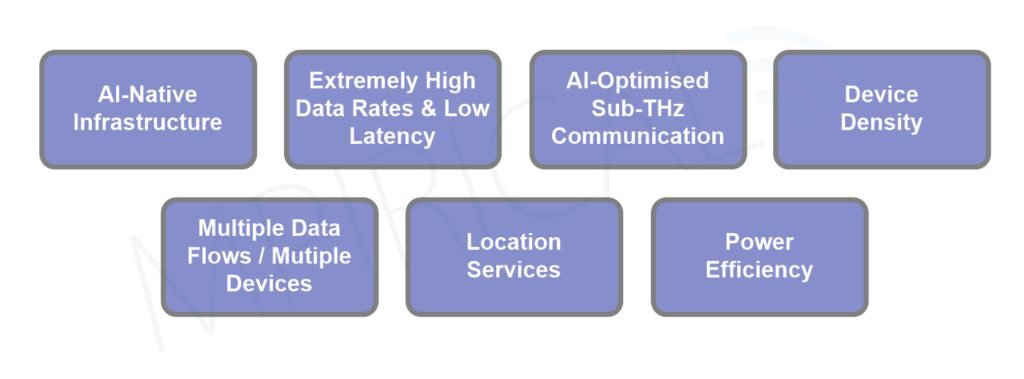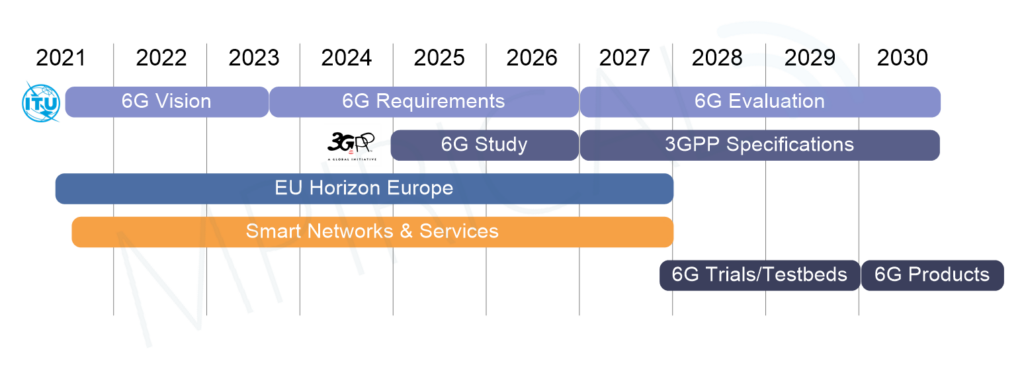
On the Road to 6G – Part 2
Part 2 – IMT 2030 and 6G
 In last month’s blog, we briefly reviewed the status of global mobile subscriptions before discussing the latest iteration of the 5G specifications from the 3GPP – Release 18 or 5G Advanced. In Part 2, we shall endeavor to investigate what the future may hold for mobile telecommunications and postulate what 6G or IMT 2030 may look like.
In last month’s blog, we briefly reviewed the status of global mobile subscriptions before discussing the latest iteration of the 5G specifications from the 3GPP – Release 18 or 5G Advanced. In Part 2, we shall endeavor to investigate what the future may hold for mobile telecommunications and postulate what 6G or IMT 2030 may look like.
If history is anything to go by, 6G will be the technology for the 2030s as per each previous iteration: 1990s (2G), 2000s (3G), 2010s (4G) and 2020s (5G). In fact, the ITU-R’s Working Part 5D (WP 5D) has already started development on their “IMT Vision for 2030 and Beyond” and in so doing, set out several key broad objectives and invited organizations to begin collaboration. Furthermore, numerous projects throughout the world have already begun investigating the next generation of mobile technology and have now begun to shape out what 6G may bring.
Clearly, 6G will represent a significant step forward in terms of capacity, coverage, user data rates, and lower latencies but it will also attempt to bridge the digital divide, tackle the UN Sustainable Development Goals, and support the development of a “Ubiquitous Intelligent Mobile Society”. These worthy aspirations are a long way removed from the technical requirements set out for GSM in the 1980s, but this only goes to confirm the criticality of digital communications within society and its role in tackling the many challenges that lie ahead.
At Mpirical, we certainly don’t claim to have the answers to all society’s problems, but we do know a few things about mobile technology and the anticipated requirements of 6G. We shall therefore now take this opportunity to focus on some of the technological requirements and enablers of 6G.
Technology Requirements
AI-Native Infrastructure
6G is anticipated to be the first fully AI-native mobile network, meaning that AI will not just be an enhancement but a fundamental component of its operation. Unlike 5G, where AI is used for optimising existing network functions, 6G networks will be designed from the ground up to be AI-driven. This means that AI will influence spectrum allocation, network slicing, energy consumption, security protocols, and even real-time traffic steering.
Extremely High Data Rates
5G introduced peak data rates of 20 Gbps, but 6G is expected to push the limits towards 1 Tbps speeds, enabling ultra-high-definition holographic communications and immersive digital experiences. Latency is also projected to drop below 100 microseconds, further enhancing the feasibility of real-time applications such as brain-computer interfaces (BCIs) and remote robotic control.
AI-Optimised Specrum and Sub-THz Communication
6G will likely incorporate sub-terahertz (THz) frequencies (90-300Ghz) to support higher data throughput. While sub-THz spectrum faces propagation challenges, AI-driven signal processing will enable adaptive transmission and enhance coverage. AI will also be essential in managing spectrum sharing between terrestrial and non-terrestrial networks.
Very Wide Coverage
If 6G is going to “bridge” the digital divide, then its availability will need to be universal and ever present. To this end, it cannot be limited to city centres but instead reach across whole communities in urban and rural locations – in both developed and developing counties. Sensors measuring climate change for example may be deployed across large geographic areas covering forests, deserts and the oceans which will necessitate the inclusion of non-terrestrial infrastructure to support the demands of both coverage and capacity.

Device Density
Whereas 5G supports up to 1 million devices per square kilometer, 6G will need to accommodate at least 10 million connections per square kilometer. This density will be crucial for smart cities, industrial automation, and autonomous systems.
Multiple Data Flows / Multiple Devices
Emerging uses cases such as XR (Extended Reality) and holographic communications will call upon multiple synchronized data flows, each potentially associated with a different sense, touch, sound, sight and even potentially taste and smell. Furthermore, multiple devices may be required, each potentially in a different location, if a true immersive experience is to be provided.
Locations Services
Whereas current mobile technologies can accurately locate a device, many of the anticipated 6G use cases call upon greater levels of accuracy in not only tracking the device but also its orientation within its environment. That is, being situationally aware of its position in not just three dimensions but also its pitch, yaw, rotation, and velocity; all in near real time.
Power Efficiency
Not only must the next generation of mobile technologies be power efficient to reduce their “digital carbon” and effect on climate change but also to enable devices to operate in remote and inhospitable locations where recharging or replacing batteries is not viable. 6G will therefore need to extend the current power saving techniques such that energy can be “harvested” locally and thereby enabling devices to remain operational for decades, a key requirement if smart sensors are to be embedded into national infrastructure such as roads, bridges, and buildings. Furthermore, next generation protocols will need to be “power aware” and careful consideration will need to be given to the chosen radio frequencies.
Technology Enablers
Setting the technical requirements for a 6G network is one thing but to actually achieve them is quite another and thus, will call upon the evolution of numerous enabling technologies.

AI-Native Network
Introduced in 5G and 5G Advanced, the role of AI / ML within the RAN (Radio Access Network) is only going to increase in importance. This will include not only the optimization of the operational 6G air interface but also in its initial design and later deployment.
6G Optimized Cloud and Edge Computing
In the 5G era, the “cloudification” of the 5GC (5G Core) has enabled service providers to build and operate scalable applications in dynamic cloud environments through the deployment of microservices. Furthermore, this approach is already extending into the RAN through developments such as O-RAN (Open – Radio Access Network), so the advent of 6G will further drive this cloud native approach across the entire network ecosystem and blur the lines between RAN, Core and Edge. Thus, network operation is anticipated to be dynamically assigned within a hierarchy of data centers across the entire network topology due to available resources, connectivity requirements, latency, and energy consumption.
With the anticipated growth in both low bandwidth devices forming massive IoT networks, in addition to high bandwidth devices such as CCTV cameras, vast amounts of data is going to be generated at the edge of the network. Therefore, rather than transporting this information across the entire network, AI / ML will need to be positioned at the network edge to extract useful patterns from the data sets to detect and predict future outcomes. Furthermore, to realize the full benefits of this “intelligence”, real-time analysis may be required further calling upon the low latency benefits of edge computing.
Network Sensing
Sensing is likely to become a key feature in 6G networks as radio signals can be used to determine the location and position of objects. This can be combined with other sensors to create exciting new use cases such as digital twins and holographic telepresence.
Quantum Computing and Communications
Whilst Quantum Computing may be some way off in terms of commercialization and wider public use, we can anticipate that there will be new developments in Computing and AI that will drive new developments. It is also critical to consider the impact that the emergence of quantum would have on existing encryption methods – it is likely that quantum-secure cryptography will need to be considered.
The Road Ahead
While 6G remains in the research and conceptual phase, standardization efforts are expected to ramp up between 2025 and 2028, with the first commercial deployments likely in 2030 or beyond. Figure 5 illustrates the expected timeline in terms of the development of both IMT-2030 and the 3GPP (3rd Generation Partnership Project) specifications. Throughout the world there will be a number of working groups and partnership projects that will also contribute to the development of technical frameworks and specifications. Late 2027-28 will see the emergence of 6G trials and testbeds prior to a public rollout which is expected to begin in 2030. Note that this figure is specific to Europe and there are other working groups and partners globally that are contributing to the research and development of 6G.

The coming years will be defined by increasing AI integration, spectrum efficiency, and the push towards an energy-efficient, intelligent, and ubiquitous mobile ecosystem. In the meantime, 5G Advanced continues to evolve, serving as a critical stepping stone towards 6G.
This blog was updated on 25th March 2025 by Kevin Moore.
